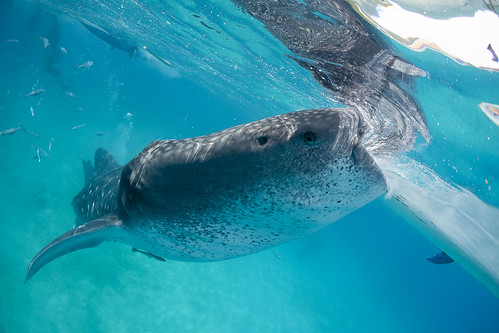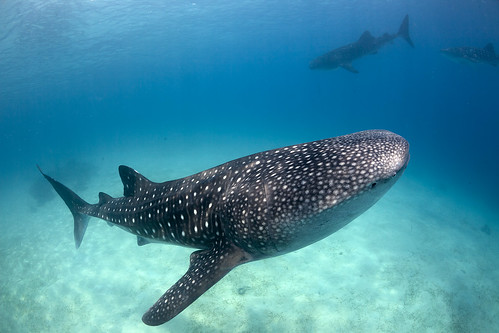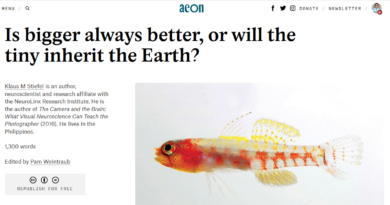Go and Swim with the Whale Sharks of Oslob!
Last week I and my friends Bo and Chang-Le went to see the whale sharks in Oslob, Cebu. This is a unique dive: You suit up on the shore of a little seaside village in the south of Cebu, walk into the water, swim out for about 50 meters and there they are: several individuals of the largest fishes in the world, Rhincodon typus, the whale shark. Whale sharks are pacifistic filter feeders, and that’s why they are there: They are being fed small shrimp by local whale shark feeders, guys in small outrigger row boats who toss shrimp into the water. Originally, the locals started doing that to keep the whale sharks away from other guys who were fishing and who were bothered by the whale sharks. A few years ago they switched to feeding the sharks so that tourists on scuba and snorkel could observe them.
As far as I could judge, the whale sharks seemed to be mostly healthy. One had a slightly bent – broken and healed – tail fin, which did not seem to keep it from swimming properly. Another one had a small piece of lip missing. Did that happen during the feeding in Oslob? I don’t know, possibly. The animals seemed to be energetic and in a good nutritional state.

We got a briefing before heading to the sharks which instructed us not to touch the sharks and to not wear sunscreen. With us three were about 5 other divers and maybe 25 snorkelers in the water, with the divers (presumably more competent ocean citizens) very well behaved, and the snorkelers at least not doing anything crass.
The criticism of the situation is that it modifies the behavior of the sharks. Yes, it does, but guess what: we as Homo sapiens have been modifying animal behavior on this planet since we came into existence as a species about 100 000 years ago. Our domesticated animals are prime examples, but a lot of wildlife is equally acting very human-influenced all over the planet. In the national parks around Sydney, crows, sulfur crested cockatoos (large white parrots) and kookaburras (Australian terrestrial kingfishers) are begging for barbecue leftovers. Not natural, but fun to watch.
There are also multiple other sites where shark feeding takes place, but in these cases it’s the feeding of piscivore reef sharks. It’s done in Fiji, Micronesia, the Great Barrier Reef and other locations by respectable diving operators. A tuna head is lowered into the water, and grey reef sharks, blacktip reef sharks and sometimes bull sharks come by to take a bite. It’s a great photo opportunity and a chance to observe these fast swimming animals up-close.
In Kona, Hawaii divers have the chance to do a night dive with giant manta rays. It’s a cool dive, and I have done it a few times. Strong dive lights attract plankton in a bay just north of Kona, and the mantas, connoisseurs of a tasty plankton dinner, visit almost every evening to filter the small organisms out of the water above the lights. These mantas seem outright playful and are very comfortable with divers at this point. A few have cuts and bruises, presumably from collisions during these night encounters with humans, but a population of mantas has been coming back to this event for many years.
Do all of these man-wildlife interactions change animal behavior? Certainly. Do they harm the animals? Possibly, but not necessarily. It’s an empirical question. Providing a supplementary food source is not necessarily a bad thing. The manta ray population in Hawaii has not collapsed as a consequence of the plankton attracted by human dive on so many nights. The whale sharks in Oslob are not dying off, and recently even a 2 meter whale shark baby has appeared on the scene. Don’t get me wrong: I am certainly in favor of a very careful management of the whale shark feeding in Oslob, but I don’t condemn it a priori because it’s “not natural”. Given the horrible things humanity does to the planet’s ocean these days (overfishing, pollution, ocean acidification, …), I can’t get too worked up about the intrusion into shark and ray behavior happening during this and the other aforementioned dives.

And even whale sharks are being fed in other places. In Okinawa, Japan, my former place of residence, juvenile whale sharks are kept in a netted enclosure (unlike in Oslob where the sharks are free to come and go) for divers to swim with. The Japanese are rightfully known as supreme animal abusers, and they don’t disappoint in this case either: the whale sharks are poorly fed and usually don’t make it very long before they “go away” (as it’s dishonestly put over there). This “attraction” used to be advertised in many cabs in Okinawa when I was living there (until 2011 – I suspect it’s still going on?). If you want to do something for the whale sharks, I suggest you protest that cruel situation.
In a recent rather shallow analysis of the Oslob whale shark watching published in the Huffington Post, the author claims that tourists ride on the whale sharks. As noted in the article, that did not happen in Oslob but in a nearby town. Nothing like that happened when I was in Oslob, in fact the Filipino guides were very good at pulling the snorkeling tourist away from the sharks when they got too close. The author also claims that the sharks are “virtually kept captive” by the feeding and are entrapped and encircled by the feeder’s boats. It’s beyond me how a skinny dude in a small row boat on the surface could keep a super massive fish very well capable of diving below the boat “entrapped”. And since the whale sharks usually dive to depths of about 200 meters every afternoon after the feeding sessions (as tagging studies have shown), it’s a bit of a stretch to say that they are “captive”.
Let me put it this way: I don’t write anything about medieval harp music, since I don’t know anything about the topic. Ms. Sowter, the author of the Huffington Post article, should use the same reasoning when it comes to marine biology. The experience at Oslob might have violated her expectation of a serene nature encounter, but that does not mean it’s detrimental for the whale sharks. I enjoyed the experience, and the chance to spend so much time with these largest living fish. It was more of an experience akin to interacting with a habituated parrot in an Aussie national park than akin to seeing a Jaguar after a two day hike into the jungle, but an enjoyable experience nevertheless.
Given the usual realities of man-ocean interaction in the Philippines I enjoyed seeing country Filipinos take care of a marine animal. The local seafood markets in the Philippines have surprisingly small fish for offer, a sign that the oceans here are drastically overfished in many places. The nice large groupers and parrotfish are typically reserved for tourists with thick wallets these days. In that context, seeing the locals make a living by not killing marine life is positive. For marine live aficionados like me and my two friends last week in Oslob, the place provides a unique chance to observe these imposing fish. For many visitors the sharks might only be a curiosity, but for some it might spark a deeper interest in the ocean. I say, go and see the whale sharks of Oslob!
